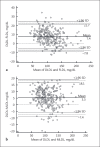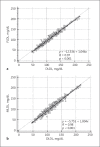Usefulness of the Martin Method for Estimation of Low-Density Lipoprotein Cholesterol in Coronary Atherosclerosis
- PMID: 29202484
- PMCID: PMC5968229
- DOI: 10.1159/000485977
Usefulness of the Martin Method for Estimation of Low-Density Lipoprotein Cholesterol in Coronary Atherosclerosis
Abstract
Objective: This study was conducted to validate the Martin method in coronary atherosclerosis in comparison with the Friedewald equation.
Subjects and methods: A total of 299 participants with a coronary artery calcium score (CACS) ≥300 and a serum triglyceride (TG) level <400 mg/dL at Seoul National University Hospital Healthcare System Gangnam Center, Seoul, Korea, were enrolled in this study. Low-density lipoprotein cholesterol (LDL-C) was directly measured with a homogeneous assay (DLDL) and estimated by both the Friedewald equation (FLDL) and Martin method (MLDL). Overall concordances between DLDL and LDL-C estimates were calculated as the percent agreement. The McNemar test was used to compare the rate of reclassification of participants with FLDL and MLDL, and to determine which differed significantly from each other.
Results: Overall concordance between DLDL and MLDL was slightly higher than that between DLDL and FLDL (73.2 vs. 70.9%, p < 0.001). The FLDL showed poor performance when the TG level was ≥200 mg/dL, mostly by underestimation, which represented a 64.7% discordance with DLDL. The reclassification rate by MLDL, however, did not exceed 35.3% in all of the TG groups.
Conclusions: The Martin method to estimate LDL-C using the strata-specific TG:VLDL ratio showed a 2-fold better concordance with LDL-C measured with a direct homogeneous assay in coronary atherosclerosis compared to the Friedewald equation when the TG level was ≥200 mg/dL. This finding suggests that MLDL could be a better alternative for estimating LDL-C compared to FLDL when the TG level is ≥200 mg/dL in coronary atherosclerosis.
Keywords: Coronary atherosclerosis; Friedewald equation; Low-density lipoprotein cholesterol.
© 2017 The Author(s) Published by S. Karger AG, Basel.
Figures




Comment in
-
Martin Method for Estimation of Low-Density Lipoprotein Cholesterol.Med Princ Pract. 2018;27(5):499. doi: 10.1159/000492894. Epub 2018 Aug 14. Med Princ Pract. 2018. PMID: 30107386 Free PMC article. No abstract available.
-
Reply to the Comment Entitled "Martin Method for Estimation of Low-Density Lipoprotein Cholesterol".Med Princ Pract. 2018;27(5):500. doi: 10.1159/000492909. Epub 2018 Sep 10. Med Princ Pract. 2018. PMID: 30199866 Free PMC article. No abstract available.
Similar articles
-
Correlation of extended Martin/Hopkins equation with a direct homogeneous assay in assessing low-density lipoprotein cholesterol in patients with hypertriglyceridemia.J Clin Lab Anal. 2023 Sep;37(17-18):e24963. doi: 10.1002/jcla.24963. Epub 2023 Sep 7. J Clin Lab Anal. 2023. PMID: 37679962 Free PMC article.
-
Comparison of existing methods of low-density lipoprotein cholesterol estimation in patients with type 2 diabetes mellitus.Ann Acad Med Singap. 2023 Jun 27;52(6):280-288. doi: 10.47102/annals-acadmedsg.2022477. Ann Acad Med Singap. 2023. PMID: 38904509
-
Comparison of Various Low Density Lipoprotein Cholesterol Calculators: Is It Time for the Friedewald Equation to Go in India?J Assoc Physicians India. 2024 Sep;72(9):e1-e5. doi: 10.59556/japi.72.0645. J Assoc Physicians India. 2024. PMID: 39291520
-
Accuracy of 23 Equations for Estimating LDL Cholesterol in a Clinical Laboratory Database of 5,051,467 Patients.Glob Heart. 2023 Jun 19;18(1):36. doi: 10.5334/gh.1214. eCollection 2023. Glob Heart. 2023. PMID: 37361322 Free PMC article.
-
Update on low-density lipoprotein cholesterol quantification.Curr Opin Lipidol. 2019 Aug;30(4):273-283. doi: 10.1097/MOL.0000000000000611. Curr Opin Lipidol. 2019. PMID: 31135594 Review.
Cited by
-
Correlation of extended Martin/Hopkins equation with a direct homogeneous assay in assessing low-density lipoprotein cholesterol in patients with hypertriglyceridemia.J Clin Lab Anal. 2023 Sep;37(17-18):e24963. doi: 10.1002/jcla.24963. Epub 2023 Sep 7. J Clin Lab Anal. 2023. PMID: 37679962 Free PMC article.
-
Validation of Friedewald, Martin-Hopkins and Sampson low-density lipoprotein cholesterol equations.PLoS One. 2022 May 13;17(5):e0263860. doi: 10.1371/journal.pone.0263860. eCollection 2022. PLoS One. 2022. PMID: 35559957 Free PMC article.
-
Assessing Performance of Martins's and Sampson's Formulae for Calculation of LDL-C in Indian Population: A Single Center Retrospective Study.Indian J Clin Biochem. 2024 Oct;39(4):579-585. doi: 10.1007/s12291-023-01142-3. Epub 2023 Jul 7. Indian J Clin Biochem. 2024. PMID: 39346721
-
Martin Method for Estimation of Low-Density Lipoprotein Cholesterol.Med Princ Pract. 2018;27(5):499. doi: 10.1159/000492894. Epub 2018 Aug 14. Med Princ Pract. 2018. PMID: 30107386 Free PMC article. No abstract available.
-
Reply to the Comment Entitled "Martin Method for Estimation of Low-Density Lipoprotein Cholesterol".Med Princ Pract. 2018;27(5):500. doi: 10.1159/000492909. Epub 2018 Sep 10. Med Princ Pract. 2018. PMID: 30199866 Free PMC article. No abstract available.
References
-
- World Health Organization Cardiovascular diseases: fact sheet. 2016. http://www.who.int/mediacentre/factsheets/fs317/en/ (accessed March 22, 2017).
-
- LaMonte MJ, FitzGerald SJ, Church TS, et al. Coronary artery calcium score and coronary heart disease events in a large cohort of asymptomatic men and women. Am J Epidemiol. 2005;162:421–429. - PubMed
-
- Detrano R, Guerci AD, Carr JJ, et al. Coronary calcium as a predictor of coronary events in four racial or ethnic groups. N Engl J Med. 2008;358:1336–1345. - PubMed
-
- Catapano AL, Graham I, De Backer G, et al. ESC/EAS guidelines for the management of dyslipidaemias. Eur Heart J. 2016;37:2999–3058. - PubMed
-
- Expert Panel on Detection and Treatment of High Blood Cholesterol in Adults Executive summary of the third report of the National Cholesterol Education Program (NCEP) expert panel on detection, evaluation, and treatment of high blood cholesterol in adults (Adult Treatment Panel III) JAMA. 2001;285:2486–2497. - PubMed
MeSH terms
Substances
LinkOut - more resources
Full Text Sources
Other Literature Sources
Medical
Miscellaneous

